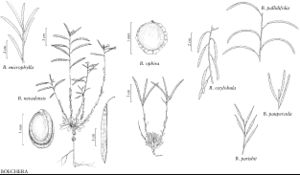Boechera oxylobula
Phytologia 51: 370. 1982.
Perennials; short to long-lived; (cespitose); sexual; caudex usually not woody. Stems usually 3–7 per caudex branch, arising from margin of rosette near ground surface, or arising laterally proximal to sterile shoots, 0.4–2.5 dm, glabrous or pubescent proximally, trichomes simple and short-stalked, 2-rayed, 0.1–0.4 mm, glabrous distally. Basal leaves: blade linear to linear-oblanceolate, 1–2.5 mm wide, margins usually entire, rarely denticulate, often ciliate, trichomes (simple), 0.3–0.7 mm, surfaces glabrous or sparsely pubescent, trichomes short-stalked, 2-rayed or 3-rayed, 0.1–0.4 mm. Cauline leaves: 3–12, not concealing stem; blade auricles absent, surfaces of distalmost leaves usually glabrous, rarely sparsely pubescent. Racemes 2–12-flowered, unbranched. Fruiting pedicels divaricate-ascending to horizontal, slightly to strongly recurved, 3–8 mm, glabrous or sparsely pubescent, trichomes (isolated), simple. Flowers ascending-divaricate at anthesis; sepals glabrous or pubescent; petals white to pale lavender, 4–5 × 1.5–2 mm, glabrous; pollen ellipsoid. Fruits pendent, not appressed to rachis, not or, rarely, weakly secund, straight, edges parallel, 1.5–3.5 cm × 1.2–2 mm; valves glabrous; ovules 28–44 per ovary; style 0.1–0.4 mm. Seeds uniseriate, 0.9–1.2 × 0.6–1 mm; wing often continuous, 0.07–0.1 mm wide.
Phenology: Flowering May–Jul.
Habitat: Cliffs, rocky slopes, gravelly soil in sagebrush and open conifer forests
Elevation: 2100-3600 m
Discussion
Most of the collections assigned here have been called Arabis (Boechera) demissa by other authors (e.g., R. C. Rollins 1993; N. H. Holmgren 2005b). Because the holotype of A. demissa is identical to B. oxylobula in nearly every way (see M. D. Windham and I. A. Al-Shehbaz 2006 for detailed comparison), we treat them as conspecific. Boechera oxylobula is restricted to Garfield, Gunnison, Hinsdale, Lake, Mineral, Park, and Saguache counties in central Colorado. The taxon traditionally treated as A. (Boechera) demissa var. languida is here recognized as an apomictic species of hybrid origin (see Windham and Al-Shehbaz 2007b for detailed comparison).
Selected References
None.
Lower Taxa
"elongated" is not a number."thick" is not a number."dm" is not declared as a valid unit of measurement for this property.

